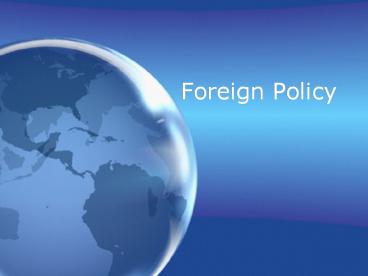Foreign Policy - PowerPoint PPT Presentation
Title:
Foreign Policy
Description:
Foreign Policy Definitions Foreign ... E.g China, Israel, Pakistan, ... Nixon opened diplomatic relations with communist China. Normal trade relations were ... – PowerPoint PPT presentation
Number of Views:285
Avg rating:3.0/5.0
Title: Foreign Policy
1
Foreign Policy
2
Definitions
- Foreign Policy is the goals the US wants to
achieve in the world, along with the techniques
and strategies used to achieve these goals. - E.g. If we want stability in the Middle East, we
may use diplomacy, economic aid, technical
assistance, and military intervention.
3
National Security Policy
- This is a main goal of foreign policy.
- The National Security Council acts as an advisory
body to the president - The State Department is responsible for our
foreign diplomatic core and policy. - Defense policy is part of national security
policy, and the president relies on the
Department of Defense for this policy.
4
Moral Idealism
- This is a foreign policy based on moral
considerations. It projects the US as a nation
that helps other nations, and spreads American
good will - E.g Woodrow Wilsons League of Nations
- JFKs Peace Corps
- Jimmy Carters emphasis on Human Rights
5
Political Realism
- This is foreign policy sees the world as a
dangerous place, and the US must defend itself. - The Truman Doctrine sought to contain the spread
of communism - The current policy after 9/11 is designed to
defeat terrorism
6
Mixture of goals
- Most US foreign policy contains a mixture of
moral idealism and political realism. - For example, George W. Bushs policy is Iraq was
explained as ending the evil Saddam regime, that
oppressed the Iraqi people. - In addition, he stressed overthrowing Saddam as a
way to end an imminent Iraqi threat against the
US, due to weapons of mass destruction.
7
Powers of Congress in Foreign Policy
- Congress has power to declare wars (Article 1
section 8) - It has declared war five times in our history
War of 1812, Mexican-American War 1846, Spanish
American War1898 , WW 1 1917, and WW 2 1941) - War Powers Act passed in 1973 - President must
report to Congress after sending troops. Needs
Congressional approval after 60 days.
8
Congressional control continued
- Congress (the Senate) ratifies treaties
- Congress controls monies for foreign policy (eg.
Dept. of State and Defense) Through appropriation
bills. - The Congress also must confirm key foreign policy
appointments of President, such as the Secretary
of State and Secretary of Defense.
9
Presidential Power in Foreign Policy
- Congress declares war, but the President is
deemed Commander and Chief of the Armed forces in
Article II of the Constitution - The President can send troops into battle for 60
days without Congressional approval (War Powers
Act)
10
- The Senate must confirm treaties, but the
President may sign Executive Agreements with
other countries without congressional approval.
(95 of modern agreements are Executive
Agreements, not treaties) - President has informal powers in foreign policy
including the bully pulpit used to persuade the
American public.
11
Presidential Powers
- The Executive Branch has four important foreign
policy making groups Department of State, The
National Security Council, the CIA, and the
Department of Defense. - President has access to top secret information
daily, and therefore is considered to be more
expert than the Congress on crucial foreign
policy decisions.
12
Critiques of Foreign Policy
- Some critics argue that the President has become
too powerful in carrying out foreign policy,
without Congressional approval (The Imperial
Presidency) - What do you think?
13
Internationalism v. Isolationism
- The American public has both of these tendencies.
- For example, in the isolationism of the 30s was
shattered by Pearl Harbor in 1941. Or the The
Cold War and the policy of containment kept the
US active in international affairs.
14
Unilateral vs. Multilateral
- Unilateral means a nation acts without partners,
on its own. - Multilateral means a nation works in partnership
with others - E.g.United Nations (UN)
15
Nuclear Proliferation
- The build up of nuclear arsenals during the Cold
War, was primarily between the US and the Soviet
Union.Since the fall of the Soviet Union, there
has been the spread of nuclear capability. - E.g China, Israel, Pakistan, and India have the
bomb. Iran is able to enrich uranium and North
Korea has said it has nuclear capability. - Clintons Nuclear Test Ban Treaty was not
ratified by Congress in 1999.
16
China
- China is an emerging world power, with a fast
growing private economy. - Nixon opened diplomatic relations with communist
China. - Normal trade relations were established between
China and the US and China joined the World Trade
Organization (WTO) - China has come under criticism for human rights
abuses against its citizens and Tibetans.
17
Debate over Afghanistan
- Current US policy is focused on withdrawing all
US troops by 2014 - Majority of Americans want to withdraw from
sooner. - Obamas Afghan policy focuses on training Afghan
forces to resist Al Qaeda and Taliban - What do you think?
18
President Obamas Foreign Policy
- What aspects of President Obamas foreign policy
would you say represents moral idealism and
political realism? - Which aspects of President Obamas foreign policy
do you agree with, and which aspects do you
disagree with?




























![get⚡[PDF]❤ Hard Line: The Republican Party and U.S. Foreign Policy since World War II PowerPoint PPT Presentation](https://s3.amazonaws.com/images.powershow.com/10051196.th0.jpg?_=20240608115)


